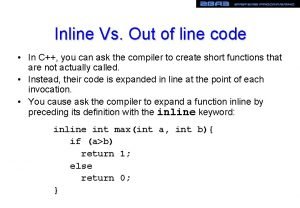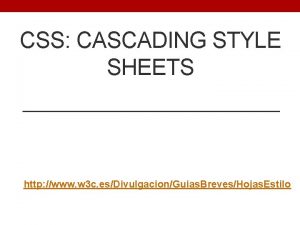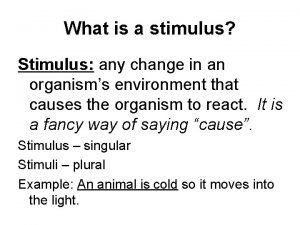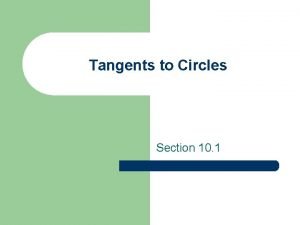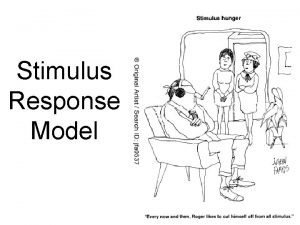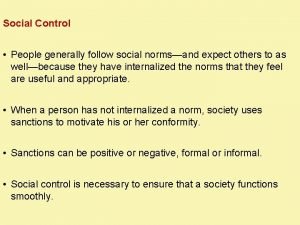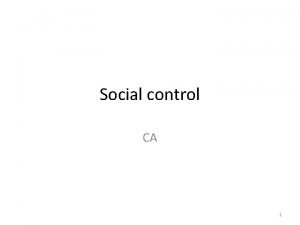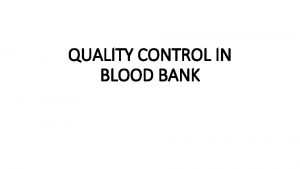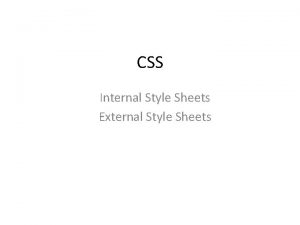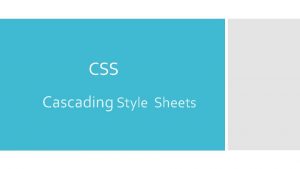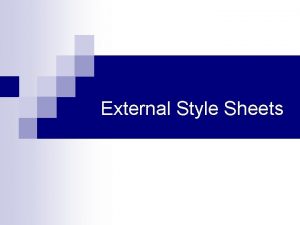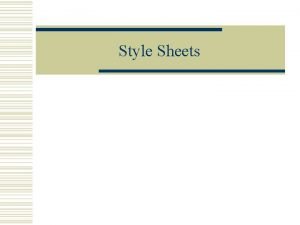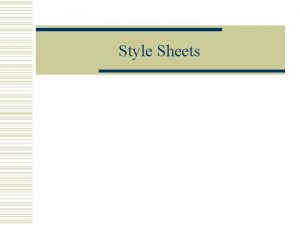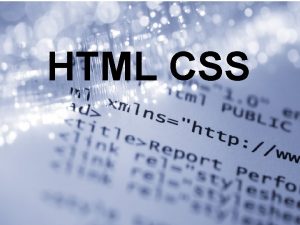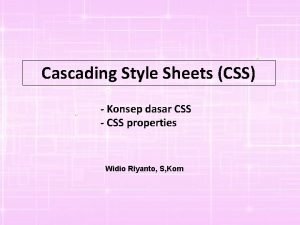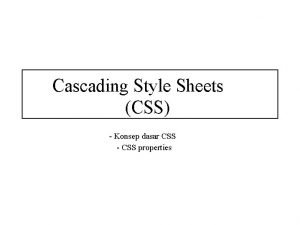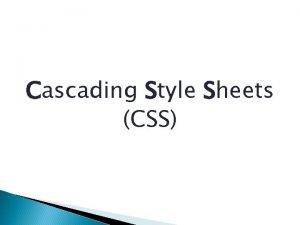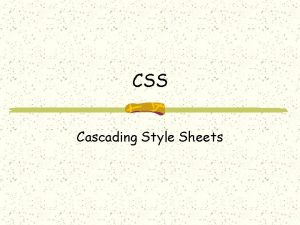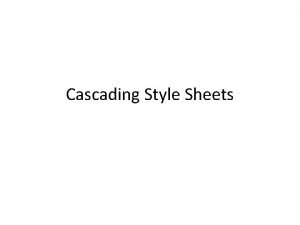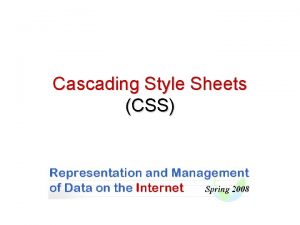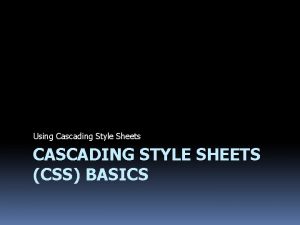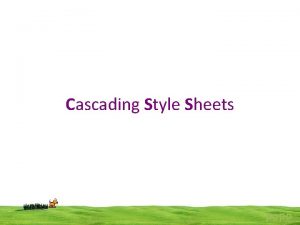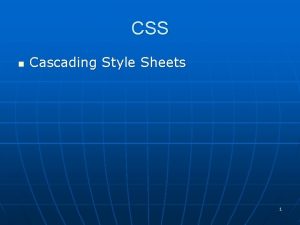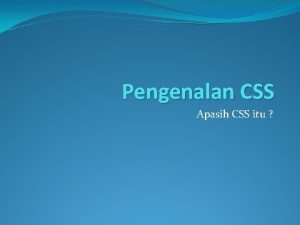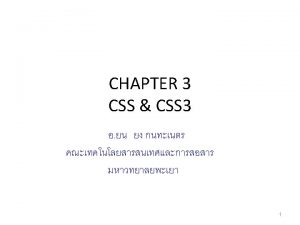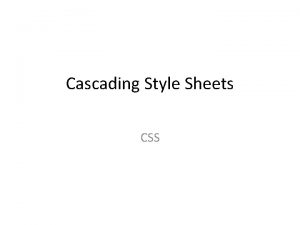CSS Internal Style Sheets External Style Sheets Learning





















- Slides: 21

CSS Internal Style Sheets External Style Sheets

Learning Objectives By the end of this lecture, you should be able to: – Distinguish between inline, internal, and external styling. – Apply the three types of styles. – Recognize who “wins” when there is a disagreement between the three styles.

Review: Selectors, Properties, Values Recall that every style has three components: q Selectors: q i. e. tags such as: body, p, h 2, img, etc. q Properties: q e. g. color, background-color, font-family, textalign, width, height q Values: q #ff 0000 (the color red), italic, center, 200 px 3

Inline Style • The style is placed inside the tag. • The style is applied to that tag - and that tag only! Any subsequent tags – even of the same selector will not have those styles applied, unless you rewrite them out each time. <body> <h 3 style="font-style: italic; color: #ff 0000; "> This h 3 uses an inline style </h 3> <h 3>The styles in the tag above will NOT apply to this tag. </h 3> </body> 4

Three ways of creating a style: Inline, Internal, External Inline style – An inline style is applied to a single tag (or div section) of the current HTML document. – Inline style declarations are placed inside the tag. – <h 1 style="font-size: 200%; font-style: italic; "> Internal style sheet (also called “embedded” style sheet) – An internal style is applied to the entire current HTML file but is not applied to other files on the website. – Embedded style declarations are frequently placed in the head section of the HTML file. Sometimes they are placed near the end for performance reasons. • We will place them in the <head> section for this course. External style sheet – An external style is applied to the entire HTML file and may be applied to any or all pages on the website. – External style declarations are written in a separate text file which is then linked to the HTML file. – External style sheets make it easy to give a consistent look to any number of web pages. 5

Internal Style Sheets • Styles that apply to every instance of a tag within the current HTML document. • i. e. They will not apply to other pages on your website. • • • The styles are placed not inside the tag as with inline styles, but rather, between <style> and </style> tags. This section is typically placed inside the <head> section. The selector is identified, and then inside curly braces, we place all of the property: value pairs. <head> <title>Internal Styles</title> <meta charset="utf-8"> <style> h 1 {font-size: 200%; font-style: italic} h 2 { color: #ff 0000; } </style> </head> This line says that every h 1 tag in the current document will use this style. 6

Example: internal_style. html <head> <title>Internal Styles> <meta charset="utf-8"> <style type="text/css"> body { border: 10 px solid #335 bff; width: 300 px; } h 2 { font-family: Verdana; text-size: 140%; } h 3 { font-family: Arial; font-style: italic; color: #ff 0000; } </style> </head> <body> <h 3>This is some h 3 content. </h 3> <h 4>This is some h 4 content. </h 4> <p>Notice how the entire body has a border around it. </p> </body> Note the inclusion of the ‘type’ property in the <style> tag. This attribute is not strictly necessary in HTML 5, but some programmers like to include it, typically for backwards compatibility. You are not required to use it for this course. 7

<style type="text/css"> body { border: 10 px solid #335 bff; width: 300 px; } h 2 { font-family: Verdana; text-size: 140%; } h 3 { font-family: Arial; font-style: italic; color: #ff 0000; } </style> </head> <body> <h 3>This is some h 3 content. </h 3> <h 4>This is some h 4 content. </h 4> <p>Notice how the entire body has a border around it. </p> </body> 8

Shortcut: Applying the same style to multiple tags <style type="text/css"> h 1, h 2, h 3, h 4, h 5, h 6 { color: #ff 0000; font-family: Arial} </style> This shows that you can apply styles to several selectors (e. g. tags) at the same time. In this case, all of your h tags would be in red and Arial. Simply separate the selectors with commas. 9

External Style Sheets • You can create an entirely separate document containing all of the styles you wish to apply. Then you can link any HTML page you ever create to this one document. • To create an external style sheet, place all of your styles in a separate text file and give that file the extension. css (e. g. my_styles. css ) 10

Example of an external style sheet • • An external style sheet lives in its own separate document. This document should not have any HTML tags: An external style sheet should contain only CSS styles. – When we say "no HTML tags", this includes the <style> tag! Remember that the <style> tag is an HTML tag, not a CSS style. body favorite_styles. css { background-color: #ccffff; color : blue; } h 1 { color: #000090; font-size: 150%; } h 2 { color: #000090; font-size: 150%; } h 3 { color: #000090; font-size: 115%; } form { color: #000090; font-size: 115%; } 11

Linking to a web document to an external style sheet • Once you have created an external style sheet, you can now link any HTML document to this sheet. By linking a web document to the style sheet, all of the styles in that sheet will be applied to the web document. • To link an external style sheet to an HTML document, include the following <link> tag inside the <head> section of your HTML document: <link rel="stylesheet" href="favorite_styles. css"> This <link> tag’s attributes tell the browser to 1. 2. apply an external style sheet and that the name of that style sheet is favorite_styles. css Reminder: An external style sheet must NOT contain any HTML or Java. Script code. 12

Some benefits of external style sheets • An external style sheet lets you maintain a consistent look and feel throughout all of the pages on a website. • For example, you can link every page on your company’s website to the same style sheet. At that point, all of the styles created in your external sheet will be applied to every page on your site. • In addition, if you wish to make a change throughout your entire site, you only need to change it once within your external sheet. Your change will then be reflected throughout your entire website! 13

Recap of external style sheets q As with other programming code (HTML, Java. Script), the. css file is a text file and can be created using any text editor. q This CSS file should have no other code in it besides CSS styles. q For example, there should NOT be any HTML code in your external sheet. q This even includes the <style> tag – which, of course, is an HTML tag – not CSS! q The <link> tag which tells the current HTML document to use this external style sheet is placed inside the <head> section. 14

Summary of the syntax for the three style types With inline styles: – – styles are written directly inside the tag style= attribute is used the property / value pairs are in quotes styles apply only to the current tag With internal styles – – the styles are placed in the <head> section <style> </style> tags are used the property / value pairs are placed inside curly braces styles apply to all instances of the tag (selector) in the current web page With external style sheets – – styles are written out in a separate (external) document – a text file with a CSS extension <style> </style> tags are NOT used -- in fact, no HTML should be present the property / value pairs are in curly braces styles apply to all instances of the tag (selector) on all web pages that are linked to the style sheet 15

All three formats can be in use at the same time Suppose an external style sheet has: h 3 { color: red; text-align: left; } … and the internal style sheet has: h 3 { font-size: 20 pt } …and one particular h 3 on your page, adds one (or more) additional style(s): <h 3 style="font-family: Verdana; > Then the h 3 style for that particular tag will end up as: color: red; text-align: left; font-size: 20 pt; font-family: Verdana * Note that I did not use a hex name for the color 'red' in the above example. As indicated in an earlier talk, when practicing / experimenting, it is perfectly okay to use color names. However, for "finished" products, you should use hex names. 16

When styles collide… • It is not uncommon to find yourself in a situation where you are using an external style sheet for several web pages, only to decide you’d like to change a style on one particular page. Suppose the external style sheet has: h 3 { color: red; text-align: left; font-size: 30 pt; } … and for a particular page, you decide you want to make the font a little smaller. In this case, you can include the following internal style: h 3 { font-size: 20 pt; } Then the h 3 style for that particular page will end up as: color: red; text-align: left; font-size: 20 pt Note how the internal style “beat out” or “overrode” the external style. 17

Who’s the boss? The style with higher priority overrides/overrules/replaces the style with lower priority. This explains the name “Cascading Style Sheets”. • So, all styles from the different locations will be applied. However, when there is a disagreement: – Inline styles take precedence over internal styles – Internal styles takes precedence over external styles – Inline > (wins over) Internal > External One way to remember: The “nearer” a style is to its HTML tag, the higher the priority. 18

Multiple Styles On One Page • Within a single web page, you can have all three kinds of styles present! – Your page is linked to an external style sheet – You have added some additional styles via an internal style that were not used in the external sheet • body { background-color: #ccffff; color : blue; } h 1 { color: #000090; font-size: 150%; } h 2 { color: blue; font-size: 150%; E. g. You decide to apply an additional style to <h 2> that was not provided in the external sheet. – You used a couple of inline styles for some small individual sections <head> <meta charset="utf-8"> <title>Practice Makes Perfect</title> <link rel="stylesheet" href="favorite_styles. css"> <style> h 2 { font-family: Arial; } </style> </head> <body> <h 2 style="color: red; ">Some H 2 text. . . </h 2> Rest of page here. . . </body> } h 3 { color: #000090; font-size: 115%; } form { color: #000090; font-size: 115%; } favorite_styles. css The net effect is that the h 2 will be at size 150% (from the external sheet), in Arial font (internal style), and in red (changed from blue via the inline style). 19

Example Suppose the external style sheet has: body {font-family: Arial; text-align: left; font-size: 16 pt; } …and the internal style sheet has: body { text-align: right; } …and within the body tag, you add the inline style: <body style="font-weight: bold; "> What will the body’s properties be? font-family: Arial; text-align: right; font-size: 16 pt; font-weight: bold; Again, recall that the inline style has a priority over internal style, which, in turn, has priority over external styles. And, of course, the non-conflicting styles will continue to be applied. 20

File: css_int_ext. html • An example of a page that makes use of inline, internal, and external styles. – – Links to the external style sheet: favorite_styles. css I am not using hex-codes for the colors here, in order to make the discussion easier. <!DOCTYPE html> <html lang="en"> <head> <meta charset="utf-8"> <title>Demonstration of Internal and External Styles</title> <link rel="stylesheet" href="favorite_styles. css"> <style> body { background-color: peachpuff; } h 2 { color: green; font-family: Arial; } h 3 { color: red; } </style> </head> <body> <p>Please note that I am NOT using hex codes here. I am doing this to make it easier for purposes of this discussion. </p> <p>The first thing you may notice is that the background color for this page is 'peachpuff'. This is an example where the external style says one thing (silver) and the internal says another (peachpuff). Remember that inline "beats" internal, and internal "beats" external. </p> <h 1>Note that there is no reference to an h 1 color here on this document. The color you see here is generated by the external style sheet. </h 1> <h 3>Note that the h 3 color here is generated by the internal style sheet. </h 3> <h 3>Note that this h 3 color is still the same color. . . This is an advantage of internal/external styles over inline styles. EVERY instance of the tag on the page displays using the styles indicated. </h 3> <h 2 style="font-size: 150%; font-family: Verdana; ">And yet, if we want to apply inline styles, we can. We can either additional styles inline, and/or we can override styles from the internal/external style sheets. In this case, we override the font from the internal style in favor of the one written in the inline style. </h 2> </body> 21 </html>
 Max int c++
Max int c++ Css comprises of style rules that are interpreted
Css comprises of style rules that are interpreted Css button generator
Css button generator Syntactically awesome style sheets
Syntactically awesome style sheets Cascading style sheets outlook
Cascading style sheets outlook Cascading style sheets definition
Cascading style sheets definition Cuadro comparativo de e-learning
Cuadro comparativo de e-learning External-external trips
External-external trips External stimulus
External stimulus Internal users of accounting
Internal users of accounting Key internal stakeholders
Key internal stakeholders Internal tangent vs external tangent
Internal tangent vs external tangent Internal vs external stakeholders
Internal vs external stakeholders Stimulus response chart
Stimulus response chart Example of informal social control
Example of informal social control Pepinsky social control
Pepinsky social control Internal and external factors of nationalism
Internal and external factors of nationalism Is salamander external fertilization
Is salamander external fertilization External respiration process
External respiration process Reliability test in research
Reliability test in research Internal vs external qc
Internal vs external qc Quality control of reagents in blood bank
Quality control of reagents in blood bank
